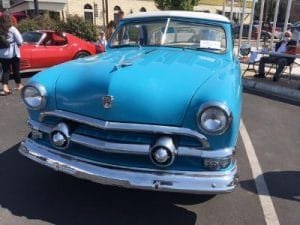Featured is a very good looking classic 1951 Ford Victoria Hardtop Coupe. The 1950’s were both unique and pivotal for automakers.The 1950’s was also what some described as the beginning of auto mania.
The Victoria model filled the desires of auto buyers who were searching for a posh and stylish post World War Two automobile.This was just two years after Ford introduced their first modern and very different looking post war models.

Ford Motor Company and Hardtops
Shortly after the introduction of it’s 1951 models, the Ford Victoria Hardtop came into being. They did quite well selling over 100,000 models and it would be another year until Lincoln and Mercury offered their hardtop models. Hudson also offered a hardtop in 1951 and Studebaker began offering hardtops in 1952. Of significance is to note that the 1951 Ford Victoria actually outsold the famous Chevy Belair. This was a first for Ford.
Ford came to the two door hardtop party a bit late however. The 1949 Buick Riviera gets the credit for America’s first mass produced two door hardtop automobile. Pontiac came out in 1950 with a hardtop on their Catalina model as Chevrolet did with it’s Bel Air and Chrysler with it’s Town and Country Newport.

To be sure their were some very early hardtops built during the early 1900’s. The first hardtops appeared during the 1915-1918 era and were called “convertible cars.” Some more were thought to be introduced during the early 1920’s by a few California automakers. After that during the 1930’s some hardtops were produced but in very small numbers and mostly by custom and luxury car automakers.,
1951 Ford Victoria Hardtop Specifications
The 1951 Ford Victoria came with a 239 cubic inch V-8 producing 100 HP. Also available with other Ford models in 1951 was the L-head 226 cubic inch six cylinder engine which delivered 95 HP.
Transmissions available included three and four speed manuals as well as a three speed automatic.
Dimensions included a wheelbase of 114.0 inches, outside overall length of 197.3 inches, width 71.7 inches. Weight averaged about 3,400 lbs.
Total U.S. new car production for 1951 was just short of 5.4 million vehicles. Ford passenger car production for the 51 model year was just over 1.0 million units. Ford Victoria Hardtop production for 1951 was 110,000 vehicles.
 Additional related Auto Museum Online articles are on the links below..
Additional related Auto Museum Online articles are on the links below..
Reference material for this article includes..Fords of the Fifties by author Michael Parris…Collectable Cars by the Editors of Consumer Reports…Ford Motor Company Archives...Classic Car Club of America…The Hemmings Motor News Book of Postwar Fords.
1951 Ford Victoria Collector Cars
 Generally just about all car and truck models from the 1950’s are popular collector cars. The decade produced some of the real classics and with power unseen in most earlier models. Styling and comfort during the 50’s ruled the day and production was setting records.
Generally just about all car and truck models from the 1950’s are popular collector cars. The decade produced some of the real classics and with power unseen in most earlier models. Styling and comfort during the 50’s ruled the day and production was setting records.
Current 1951 Ford Victoria Hardtop asking prices range from about $15,000 to $29,000. Excellently restored examples with high originality are found on the upper end of the range.
(Articles and photos copyright Auto Museum Online)
